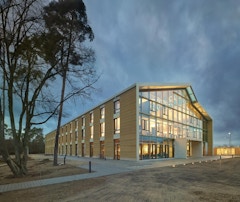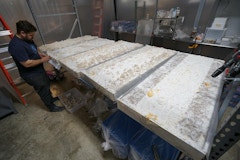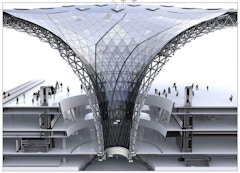
43 results
-
 Reducing greenhouse gas emissions from the building sector is critical to limiting global temperature rise to less than 1.5⁰C. Construction and…
Reducing greenhouse gas emissions from the building sector is critical to limiting global temperature rise to less than 1.5⁰C. Construction and… -
Facade Maintenance Access
- Paper by Carmen Chun, MEng, P.Eng., LEED® AP, Associate Leonard Pianalto MSc (Civil), P.Eng., LEED® AP, FEC, Managing Principal
Facades are an architectural feature and an integral part of the building enclosure. To ensure that the facades continue their function, they must be… -
Contextualizing Glass and Carbon Impacts
- Paper by Kayla Natividad, PhD, WELL AP, LEED Green Associate · Kyle Sword
Climate change goals will require significant improvements in the way buildings are constructed and operated. Building reuse can combat climate
-
Tool For Facade Inspection Traceability
- Paper by John Medina, Owner, Senior Principal Jorge Moya, Forensic and Chemical Analyst Maria Moral, Architect - Junio Principal Guillermo Saavedra, Architect - Junior Principal
Building façade inspections have multiple objectives, such as forensic investigation of a failure, maintenance code compliance, etc. Architects,… -

Active and Energy Autonomous Window
- Paper by Annalisa Andaloro · Leire Minguez Hilera · Stefano Avesani
Reducing GHG emissions related to energy use in buildings is a prominent obligation given their impact in terms of climate change. In this light,
-

Towards Net Zero Enclosures
- Paper by Jessica Santonastaso, AIA, Architect, Associate Alan Estabrook, AIA, Architect, Associate
As architects and designers we understand the urgency of addressing the building sector’s role in the ongoing environmental crisis. Architecture2030… -
Evaluating The Environmental Performance Of Stick Curtain Wall Systems
- Paper by Dima Othman · Daniel Arztmann
The construction industry is one of the greatest sources of pollution, where 39% of global energy-related carbon emissions are attributed to
-
Growing Myceliated Facades
- Paper by Thibaut Houette, M. Arch. · Brian Foresi · Christopher Maurer, AIA, NCARB · Dr. Petra Gruber
Today's sustainability in architecture takes into consideration the complete life cycle of buildings and their components, from resource harvesting
-
Carbon-Neutral High-Rise Envelope Nexus
- Paper by Thomas Spiegelhalter
The pathway to carbon-neutrality, as urged during the COP 21 in Paris, and the repeated goal for resilient buildings and urban habitats, winds right
-

The Carbon Footprint of Aluminum Fenestration
- Paper by Tom Bougher, Director of Applied Research Richard Braunstein, Vice President of R&D
The historical focus on reducing the carbon footprint of a building has recently shifted to include more emphasis on embodied carbon, the carbon… -
OpenFacadeControl
- Paper by Peter Grant, Technology Researcher II Tzu-Ching Su, Deputy Manager Luis Fernandes, Jordan Shackelford, Technology Researcher III Anand Prakash, Senior Scientific Engineering Associate Stephen Czarnecki, Software Developer Pei-Yu Yu, Deputy Division Director Feng-Yi Lin, Engineer
Automated facades are, for the most part, still considered as separate from other building systems throughout the design, installation,… -

Prefab Facades – from Prototype to Product?
- Paper by Lisa Rammig · Andrea Zani · Tim Murphy
Building envelopes are not only an immediately visible part of the building, they have also become a major factor both for cost and performance of
-
Integrated Building Control System
- Paper by Jae Yong Suk, Ph.D., Associate Professor of Design, Associate Director of California Lighting Technology Center Keith Graeber, PE, Director of Engineering Andrew Harper, PE, R&D Engineer IV Michael Siminovitch, Ph.D., Director of California Lighting Technology Center
Integrated management of commercial lighting, heating, ventilation and air conditioning systems is considered as one of the most promising building… -

The Monash Woodside Building
- Paper by Alberto Sangiorgio, Principal Façade Engineer Andrew Cortese, Managing Partner and Design Director - Sydney Office Walter van der Linde, Lead Engineer, Buildings Mechanical
Today’s environmental challenges highlight the necessity of a holistic approach to façade design and construction, key to achieve the ambitious 2030… -

Embodied Carbon Of Timber Unitized Curtain Wall
- Paper by Isabelle Hens, LEED AP BD+C, WELL AP, EIT, Environmental Designer Sophie Pennetier, Associate Director - Special Projects Simon Schleicher, Associate Professor
The building envelope is at the intersection of embodied and operational emissions. Curtain wall specifically could play an important role in… -
Form as Energy
- Paper by Matthew Fineout
All too often, high-performance building envelopes are considered in terms of new materials and technologies that push specific systems to improve
-

Facade Resilience Evaluation Framework
- Paper by Fabio Favoino, Department of energy Adèle Chalumeau, Facade engineer Audrey Aquaronne, Facade engineer
Resiliency is the capacity of a building (or building component in the case of the facade) to support building functionalities during extreme events… -
Glass in GSA Buildings
- Paper by Georgia Scalfano
Embodied carbon in buildings is a key factor in building decarbonization and while it is generally small compared to operational carbon, the
-

Window in Wall: Back to the Future
- Paper by Thomas Auer · Ata Chokhachian
In order to get to a carbon neutral building stock – which is e.g. required by the EU Carbon roadmap by 2050 – our efforts need to be smart and
-
Facade Embodied Carbon Reduction Strategies
- Paper by Isabelle Hens, LEED AP BD+C, WELL AP, Senior Environmental Designer
Facades are increasingly being recognized as a major contributor to whole-building embodied carbon. While designers know how to reduce the embodied…

